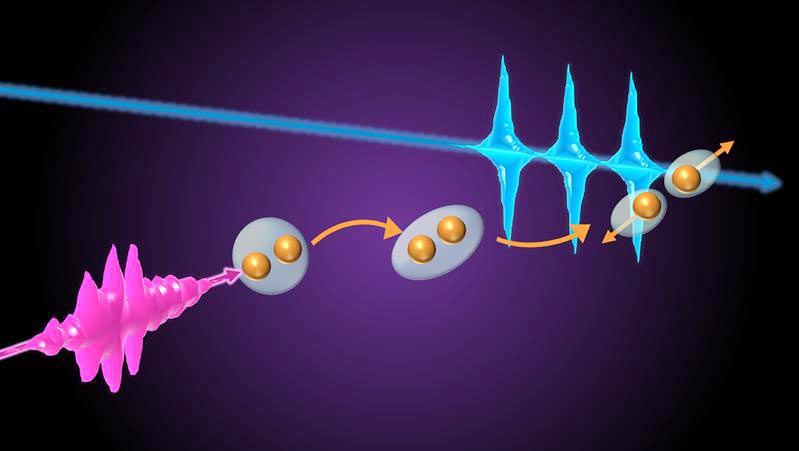
New Method Tracks Oxygen Dissociation Using UV Light Sources

Fig. 1: An XUV laser pulse (pink) excites an oxygen molecule (orange). The molecule dissociates into different atomic fragments, which can be “photographed” by another XUV laser pulse (blue).
Graphics: MPI for Nuclear Physics
For the first time, researchers have succeeded in selectively exciting a molecule using a combination of two extreme-ultraviolet light sources and causing the molecule to dissociate while tracking it over time. This is another step towards specific quantum mechanical control of chemical reactions, which could enable new, previously unknown reaction channels.
The interaction of light with matter, especially with molecules, plays an important role in many areas of nature, for example in biological processes such as photosynthesis. Technologies such as solar cells use this process as well. On the Earth’s surface, mainly light in the visible, ultraviolet or infrared regime plays a role here. Extreme-ultraviolet (XUV) light, i.e. radiation with significantly more energy than visible light, is absorbed by the atmosphere and therefore does not reach the Earth’s surface. However, this XUV radiation can be produced and used in the laboratory to enable a selective excitation of electrons in molecules. While the individual atoms in a molecule are held together by their outermost electrons in a kind of negatively charged cloud – they act as a sort of “chemical glue” – inner shell electrons are bound closer to an atomic nucleus and are therefore more localized in the molecule. It is precisely these electrons that can now be specifically excited with XUV radiation. This enables new chemical reaction processes that do not occur naturally on the Earth’s surface.
A collaboration of researchers under the lead of the group of PD Dr. Christian Ott in the Department of Prof. Pfeifer at the Max-Planck-Institut für Kernphysik in Heidelberg, Germany, now succeeded in combining two different XUV light sources for the first time, in order to temporally resolve a quantum mechanical dissociation mechanism in oxygen molecules. To achieve so, on the one hand, laser pulses are generated with the process of high harmonic generation (HHG), in which infrared light is guided through a gas cell and thereby converted into XUV radiation — known, for example, from this year’s Nobel Prize in Physics. On the other hand, a free-electron laser (FEL) is used, in which accelerated electrons emit XUV light. Both methods generate XUV pulses with a duration of femtoseconds, a millionth of a billionth of a second.
The decisive factor here is that the spectra of the two laser pulses are very different. “The HHG pulses have a very broad spectrum, which means they consist of light with many different frequencies – in the visible range this could be understood as different colours. The FEL pulses, on the other hand, are much more limited spectrally”, explains PhD student and first author of the study Alexander Magunia. The FEL pulses are generated at the free-electron laser in Hamburg (FLASH@DESY) and used to excite the electrons of the oxygen molecule into a specific state. It is known that this state then causes the molecule to dissociate via two different channels. However, it has been unclear until now, how fast this happens. This is because the atoms in the oxygen molecule have to go through a ‘quantum tunnelling’ process, which makes exact theoretical descriptions more difficult. By adding the second HHG pulse with an adjustable time delay to the first exciting FEL pulse, this molecular dissociation can now be recorded experimentally – like in a fast photo series. The HHG pulses make it possible to “photograph” all the resulting fragments at once through their spectral absorption fingerprints — a decisive step. The larger the time delay between the two pulses, the more molecules have already decayed. This increase in fragments ultimately allows to determine the duration of the process and the respective rates for the two decay channels.
The possibility of initiating targeted electronic or molecular processes with FEL pulses and independently reading out a wide range of quantum-mechanical state information about the molecule or its individual fragments with the broadband HHG spectra will hopefully make it possible to record, understand and ultimately control more complex chemical reactions with light in the future.
Wissenschaftliche Ansprechpartner:
Alexander Magunia
MPI für Kernphysik
Phone: (+49)6221 516-335
E-mail: alexander.magunia@mpi-hd.mpg.de
PD Dr. Christian Ott
MPI für Kernphysik
Phone: (+49)6221 516-577
E-mail: christian.ott@mpi-hd.mpg.de
Prof. Dr. Thomas Pfeifer
MPI für Kernphysik
Phone: (+49)6221 516-380
E-mail: thomas.pfeifer@mpi-hd.mpg.de
Originalpublikation:
Time-resolving state-specific molecular dissociation with XUV broadband absorption spectroscopy
A. Magunia, M. Rebholz, E. Appi, C. C. Papadopoulou, H. Lindenblatt, F. Trost, S. Meister, T. Ding, M. Straub, G. D. Borisova, J. Lee, R. Jin, A. von der Dellen, C. Kaiser, M. Braune, S. Düsterer, S. Ališauskas, T. Lang, C. Heyl, B. Manschwetus, S. Grunewald, U. Frühling, A. Tajalli, A. Bin Wahid, L. Silletti, F. Calegari, P. Mosel, U. Morgner, M. Kovacev, U. Thumm, I. Hart, R. Treusch, R. Moshammer, C. Ott and T. Pfeifer
Science Advances, 22 Nov 2023, DOI: 10.1126/sciadv.adk1482
Weitere Informationen:
https://www.mpi-hd.mpg.de/mpi/en/research/scientific-divisions-and-groups/quantu… Group “Excited Atoms and Molecules in Strong Fields” at MPIK
https://www.desy.de/research/facilities__projects/flash/index_eng.html Free-electron laser FLASH (DESY, Hamburg)












